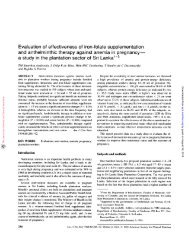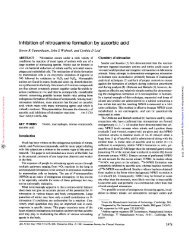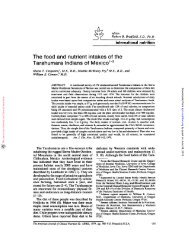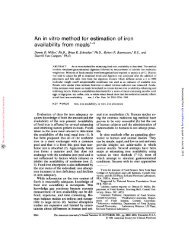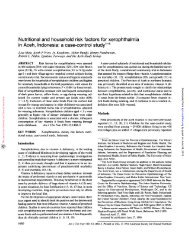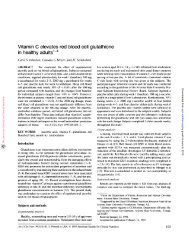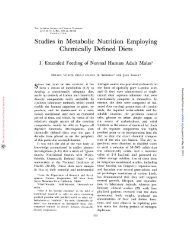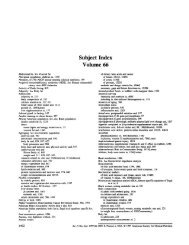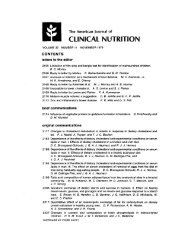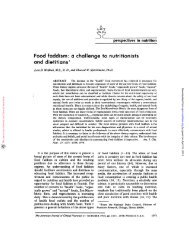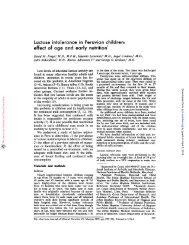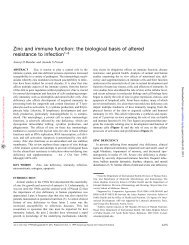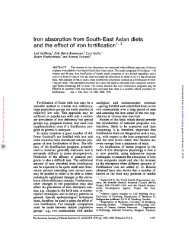Influence of D-Sorbitol on Absorption of Vitamin B12 by Patients with ...
Influence of D-Sorbitol on Absorption of Vitamin B12 by Patients with ...
Influence of D-Sorbitol on Absorption of Vitamin B12 by Patients with ...
Create successful ePaper yourself
Turn your PDF publications into a flip-book with our unique Google optimized e-Paper software.
<str<strong>on</strong>g>Influence</str<strong>on</strong>g> <str<strong>on</strong>g>of</str<strong>on</strong>g> D-<str<strong>on</strong>g>Sorbitol</str<strong>on</strong>g> <strong>on</strong> Absorpti<strong>on</strong> <str<strong>on</strong>g>of</str<strong>on</strong>g><br />
<strong>Vitamin</strong> <strong>B12</strong> <strong>by</strong> <strong>Patients</strong> <strong>with</strong> Pernicious<br />
Anemia and Achlorhydria<br />
BACON CHOW, PH.D.,* STANLEY TAUBER, M.D.,t IRVING WOLDOW, M.D.4 SAMUEL YEll, M.D.,<br />
AND BRUNO RANKE, DR. RER. NAT.’t<br />
R ECENTLY, Chow et a!.’ reported <strong>on</strong> an elixir<br />
c<strong>on</strong>taining vitamin B,2 that produced<br />
serum vitamin B,, levels in healthy young and<br />
aged people that were significantly higher than<br />
could be obtained <strong>with</strong> larger oral doses <str<strong>on</strong>g>of</str<strong>on</strong>g> vitamiri<br />
B,2 al<strong>on</strong>e. In the same paper they reported<br />
that the elixir did not seem to be effective<br />
in treating patients for pernicious anemia.<br />
Later studies <strong>by</strong> Chow and others” established<br />
that the absorpti<strong>on</strong>-enhancing factor in<br />
the elixir was D-sorbitol, a substance which is<br />
not derived from intrinsic factor. The studies<br />
also indicated that when enough D-sorbitol is<br />
adniinistered <strong>with</strong> vitamin B,, there is a statistically<br />
significant increase in absorpti<strong>on</strong><br />
<str<strong>on</strong>g>of</str<strong>on</strong>g> the vitamin <strong>by</strong> pregnant women and old<br />
4 Other investigators dem<strong>on</strong>strated<br />
this unusual property <str<strong>on</strong>g>of</str<strong>on</strong>g> D-sorbitol in normal<br />
subjects’ and in laboratory animals.’’<br />
Although D-sorbitol did not improve absorpti<strong>on</strong><br />
<str<strong>on</strong>g>of</str<strong>on</strong>g> vitamin B,, <strong>by</strong> patients <strong>with</strong> pernicious<br />
anemia, its established ability to improve<br />
absorpti<strong>on</strong> in other types <str<strong>on</strong>g>of</str<strong>on</strong>g> patients led us to<br />
test it <strong>on</strong>ce again in patients <strong>with</strong> pernicious<br />
anemia <strong>on</strong> the chance that our original finding<br />
might be in error. The effect <str<strong>on</strong>g>of</str<strong>on</strong>g> sorbitol <strong>on</strong> the<br />
From the 1)epartmiie,it <str<strong>on</strong>g>of</str<strong>on</strong>g> Biochemistry, School <str<strong>on</strong>g>of</str<strong>on</strong>g><br />
Hygiene and Public Health, The Johns Hopkins University,<br />
Baltimll Ire, Maryland.<br />
* Department (If Biochemistry, Johns Hopkins University<br />
; t Assistant in I’sIedicine afl(1 Department <str<strong>on</strong>g>of</str<strong>on</strong>g><br />
Research, Albert Einstein Medical Center, Philadelphia,<br />
Pcnnsylva,lia. 4 L)epartncmit (If Hematology, Albert<br />
Einstein Medical Center, Northern I)ivisi<strong>on</strong>, Philadclphia,<br />
Pennsylvania. § Department <str<strong>on</strong>g>of</str<strong>on</strong>g> Biocliemistr,<br />
Johns Hopkins University; Present address: Universitats-Krankenhaus<br />
Eppemid Irf, Hamburg, Germa,iy.<br />
absorpti<strong>on</strong> <str<strong>on</strong>g>of</str<strong>on</strong>g> vitamin B,, <strong>by</strong> subjects <strong>with</strong><br />
achlorhydria was also studied.<br />
MATERIALS AND METHODS<br />
<strong>Patients</strong> <strong>with</strong> Pernicious Anemia<br />
Twelve patients <strong>with</strong> pernicious anemia in remissi<strong>on</strong><br />
participated in the study. The diagnoses<br />
<str<strong>on</strong>g>of</str<strong>on</strong>g> pernicious anemia were made <strong>by</strong> b<strong>on</strong>emarrow<br />
tests and <strong>by</strong> determining the amount <str<strong>on</strong>g>of</str<strong>on</strong>g><br />
vitamin B,, excreted in the urine.<br />
In the urinary excreti<strong>on</strong> test, 2 g <str<strong>on</strong>g>of</str<strong>on</strong>g> radioactive<br />
vitamin B,, labeled <strong>with</strong> Co’#{176} (specific<br />
activity,<br />
1Sf) .tc/mg) was administered to the patient<br />
in 30 ml <str<strong>on</strong>g>of</str<strong>on</strong>g> water <strong>with</strong> which the c<strong>on</strong>tainer<br />
was rinsed. Two hours later, the patient was<br />
given an intramuscular injecti<strong>on</strong> <str<strong>on</strong>g>of</str<strong>on</strong>g> l00() g <str<strong>on</strong>g>of</str<strong>on</strong>g><br />
unlabeled vitamin B,,. Urine was then collected<br />
from the patient for 24 hours. After measuring<br />
the volume <str<strong>on</strong>g>of</str<strong>on</strong>g> urine, <strong>on</strong>e half was evaporated<br />
<strong>on</strong> a steam bath until less than 50 ml remained.<br />
The amount <str<strong>on</strong>g>of</str<strong>on</strong>g> radioactivity in this<br />
residue was measured <strong>by</strong> a scintillati<strong>on</strong> counter.<br />
Three or more m<strong>on</strong>ths later, the test was repeated,<br />
using 10 ml <str<strong>on</strong>g>of</str<strong>on</strong>g> a Go per cent aqueous soluti<strong>on</strong><br />
<str<strong>on</strong>g>of</str<strong>on</strong>g> D-sorbitol in place <str<strong>on</strong>g>of</str<strong>on</strong>g> 10 ml <str<strong>on</strong>g>of</str<strong>on</strong>g> water.<br />
Subjects <strong>with</strong> Achiorhydria<br />
A total <str<strong>on</strong>g>of</str<strong>on</strong>g> 19 subjects <strong>with</strong> achlorhydria<br />
which was diagnosed <strong>by</strong> gastric juice analysis<br />
and/or <strong>by</strong> DiagnexJ feeding were randomly divided<br />
into two groups. Group A (10 patients)<br />
received 50 ig <str<strong>on</strong>g>of</str<strong>on</strong>g> radioactive vitamin B,,<br />
al<strong>on</strong>e, and Group B (9 patients) received the<br />
#{182} Kindly supplied to us <strong>by</strong> E. R. Squibb & S<strong>on</strong>s, Inc.;<br />
equal to quinine resin.<br />
Downloaded from ajcn.nutriti<strong>on</strong>.org <strong>by</strong> guest <strong>on</strong> August 31, 2013<br />
11 nzerica n iou rue! <str<strong>on</strong>g>of</str<strong>on</strong>g> C/in iCOl Autriti<strong>on</strong> 328 Vol. 7, )Iav-June 1959
D-<str<strong>on</strong>g>Sorbitol</str<strong>on</strong>g> in Pernicious Anemia and Achlorhydria 329<br />
same amount <str<strong>on</strong>g>of</str<strong>on</strong>g> vitamin B,2 together <strong>with</strong> 10<br />
ml <str<strong>on</strong>g>of</str<strong>on</strong>g> a (jo per cent aqueous soluti<strong>on</strong> <str<strong>on</strong>g>of</str<strong>on</strong>g> D-sorbitol.<br />
These studies were c<strong>on</strong>ducted <strong>on</strong> four separate<br />
occasi<strong>on</strong>s (identified as studies 1-4), <strong>with</strong><br />
the number <str<strong>on</strong>g>of</str<strong>on</strong>g> subjects in each group shown in<br />
Table II. Two hours later all subjects were injected<br />
<strong>with</strong> 1000 jg <str<strong>on</strong>g>of</str<strong>on</strong>g> unlabeled vitamin B,2 and<br />
their urine samples were collected for 24 hours<br />
for radioactivity measurement.<br />
‘I All results are expressed as per cent <str<strong>on</strong>g>of</str<strong>on</strong>g> the 2 pg <str<strong>on</strong>g>of</str<strong>on</strong>g><br />
radiovitamin B,, given orally.<br />
6 Approximate.<br />
RESULTS<br />
<strong>Patients</strong> <strong>with</strong> Pernicious Anemia<br />
Our studies <strong>with</strong> the urinary excreti<strong>on</strong> test in<br />
more than 100 healthy subjects show that the<br />
average normal excreti<strong>on</strong> is 1 1 .0 per cent <str<strong>on</strong>g>of</str<strong>on</strong>g> the<br />
test dose <str<strong>on</strong>g>of</str<strong>on</strong>g> vitamin B,2. As shown in Table I,<br />
in the first test all patients excreted less than 1.5<br />
per cent <str<strong>on</strong>g>of</str<strong>on</strong>g> the dose <str<strong>on</strong>g>of</str<strong>on</strong>g> vitamin B,2, thus c<strong>on</strong>firming<br />
the diagnoses <str<strong>on</strong>g>of</str<strong>on</strong>g> pernicious anemia.<br />
The test <strong>with</strong> D-sorbitol dem<strong>on</strong>strated that a’60<br />
per cent aqueous soluti<strong>on</strong> <str<strong>on</strong>g>of</str<strong>on</strong>g> D-sorbitol had no<br />
effect <strong>on</strong> the absorpti<strong>on</strong> <str<strong>on</strong>g>of</str<strong>on</strong>g> orally administered<br />
vitamin B,2 <strong>by</strong> patients <strong>with</strong> pernicious anemia;<br />
D-sOrbitol increased absorpti<strong>on</strong> in <strong>on</strong>ly 1 <str<strong>on</strong>g>of</str<strong>on</strong>g> the<br />
12 patients tested (patient 5 in Table I).<br />
Subjects <strong>with</strong> Achiorhydria<br />
The data <strong>on</strong> the urinary excreti<strong>on</strong> <str<strong>on</strong>g>of</str<strong>on</strong>g> subjects<br />
TABLE<br />
Effect <str<strong>on</strong>g>of</str<strong>on</strong>g> D-<str<strong>on</strong>g>Sorbitol</str<strong>on</strong>g> <strong>on</strong> the Urinary Excreti<strong>on</strong> <str<strong>on</strong>g>of</str<strong>on</strong>g> Orally<br />
Fed RadioactiVe <strong>Vitamin</strong> B,, <strong>by</strong> <strong>Patients</strong> <strong>with</strong><br />
Patient<br />
1<br />
2<br />
3<br />
Pernicious<br />
C Only significant increase (low normal range).<br />
I<br />
Anemiaa<br />
<strong>Vitamin</strong> <strong>B12</strong><br />
+ water<br />
0.1<br />
05b<br />
05b<br />
<strong>Vitamin</strong> BI2<br />
+ sorbitol<br />
. 0.7<br />
0.5<br />
0.5<br />
4 0.1 0.1<br />
5 1.5 5.0c<br />
6 0.1 0.1<br />
7 0.5 1.0<br />
S 0.6 1.5<br />
9 - 1.2<br />
10 - 1.4<br />
11 - 0.5<br />
12 - 1.4<br />
TABLE<br />
Effect <str<strong>on</strong>g>of</str<strong>on</strong>g> D-<str<strong>on</strong>g>Sorbitol</str<strong>on</strong>g> <strong>on</strong> the l.ninary Excreti<strong>on</strong> <str<strong>on</strong>g>of</str<strong>on</strong>g> Orally<br />
Fed Radioactive \‘ita1nin B,, <strong>by</strong> Subjects <strong>with</strong><br />
Study<br />
Subject<br />
No.<br />
Achlorhvdnia”<br />
a All results are expressed as per cent <str<strong>on</strong>g>of</str<strong>on</strong>g> the 50 pg <str<strong>on</strong>g>of</str<strong>on</strong>g><br />
radiovitamin B,, given orally.<br />
b Only a small porti<strong>on</strong> <str<strong>on</strong>g>of</str<strong>on</strong>g> the 24-hour urine specimen<br />
was collected and was, therefore, discarded.<br />
C Mean and standard error. The difference in the<br />
means <str<strong>on</strong>g>of</str<strong>on</strong>g> both groups is statistically significant (p <<br />
0.01) calculated according to the Students’ t test.<br />
II<br />
Group A<br />
(vitamin B,,<br />
+ water)<br />
1 1 1.61 2.38<br />
2 1.22 3.83<br />
3 2.14 3.17<br />
2 4 0.51 1.91<br />
3 7<br />
8<br />
5 0.81 1.06<br />
6 1.66 2.34<br />
9<br />
1.73<br />
1.22<br />
0.56<br />
Group B<br />
(vitamin 1312<br />
+ sorhitol)<br />
1.35<br />
2.21<br />
b<br />
4 10 0.65 1.83<br />
MEANC 1.21 ± 0.178 2.23 ± 0.284<br />
in Groups A and B are presented in Table II.<br />
They dem<strong>on</strong>strate that a 60 per cent aqueous<br />
soluti<strong>on</strong> <str<strong>on</strong>g>of</str<strong>on</strong>g> sorbitol enhances the absorpti<strong>on</strong> <str<strong>on</strong>g>of</str<strong>on</strong>g><br />
orally administered vitamin B,2 <strong>by</strong> subjects<br />
<strong>with</strong> achlorhydria. The same effect was observed<br />
in four separate studies, and the difference<br />
in the urinary excreti<strong>on</strong> <str<strong>on</strong>g>of</str<strong>on</strong>g> radioactivity is<br />
statistically<br />
significant.<br />
DISCUSSION<br />
The finding that D-sorbitOl does not increase<br />
absorpti<strong>on</strong> <str<strong>on</strong>g>of</str<strong>on</strong>g> orally administered vitamin B,2<br />
<strong>by</strong> patients <strong>with</strong> pernicious anemia agrees <strong>with</strong><br />
the findings <str<strong>on</strong>g>of</str<strong>on</strong>g> Ellenbogen and his associatestm#{176}<br />
and c<strong>on</strong>firms our original observati<strong>on</strong>.<br />
The lack <str<strong>on</strong>g>of</str<strong>on</strong>g> efficacy clearly differentiates<br />
D-sorbitol from intrinsic factor, which <strong>by</strong> definiti<strong>on</strong><br />
must increase absorpti<strong>on</strong> <str<strong>on</strong>g>of</str<strong>on</strong>g> vitamin B,2<br />
in patients <strong>with</strong> pernicious anemia. Since<br />
D-sorbitol can be effective in increasing absorpti<strong>on</strong><br />
<str<strong>on</strong>g>of</str<strong>on</strong>g> vitamin B,, in patients where there is no<br />
dem<strong>on</strong>strable lack <str<strong>on</strong>g>of</str<strong>on</strong>g> intrinsic factor, or even in<br />
subjects <strong>with</strong> achlorhydria, it appears that<br />
there are a number <str<strong>on</strong>g>of</str<strong>on</strong>g> different mechanisms <strong>by</strong><br />
which vitamin B,, is absorbed from the gastrointestinal<br />
tract.<br />
Downloaded from ajcn.nutriti<strong>on</strong>.org <strong>by</strong> guest <strong>on</strong> August 31, 2013
330 Chow, Tauber, Woldow, Yeh, and Ranke<br />
SUMMARY AND CONCLUSIONS<br />
D-sorbitol, a substance which is not derived<br />
from intrinsic factor, has been found to increase<br />
the absorpti<strong>on</strong> <str<strong>on</strong>g>of</str<strong>on</strong>g> orally administered vitamin<br />
B,2 <strong>by</strong> certain patients who presumably possess<br />
intrinsic factor. As seen in this study, however,<br />
D-sorbitol did not increase the absorpti<strong>on</strong><br />
<str<strong>on</strong>g>of</str<strong>on</strong>g> vitamin B,, <strong>by</strong> patients <strong>with</strong> pernicious<br />
anemia, but it did enhance the absorpti<strong>on</strong> in<br />
subjects <strong>with</strong> achlorhydria. Thus, these findings<br />
together <strong>with</strong> others2’3 dem<strong>on</strong>strate that<br />
D-sorbitol can aid to some extent the absorpti<strong>on</strong><br />
<str<strong>on</strong>g>of</str<strong>on</strong>g> vitamin B,, <strong>by</strong> all types <str<strong>on</strong>g>of</str<strong>on</strong>g> subjects studied<br />
except those <strong>with</strong> pernicious anemia.<br />
REFERENCES<br />
1. C,iow, B. F. , H0R0NIcK, A., and OKUDA, K. : Effeet<br />
(If an elixir (111 the absorpti<strong>on</strong> <str<strong>on</strong>g>of</str<strong>on</strong>g> vitamin B,,<br />
<strong>by</strong> healthy young and old subjects. AM. J. CLIN.<br />
NuTRITIoN 4: 434, 1956.<br />
2. Cnow, B. F., MEIER, P., and FREE, S. M., JR.: Absorpti(I,1<br />
<str<strong>on</strong>g>of</str<strong>on</strong>g> vitamin B,, enhanced <strong>by</strong> D-s<strong>on</strong>bitol.<br />
AM. J. CLIN. NUTRITION 6: 30, 1958.<br />
3. Cnow, B. F., PRYSTOVSKY, H., HELLEGERS, A. E.,<br />
and WONG, \‘. : \itamin B,, studies: Absorpti<strong>on</strong><br />
in human pregnancy enhanced <strong>by</strong> D-s<strong>on</strong>bitol.<br />
Am. J. Obst. & Gynec. 76: 91, 1958.<br />
4. CHOW, B. F., et al. : To be published.<br />
5. CORNMAN, E. : Elevatio,, <str<strong>on</strong>g>of</str<strong>on</strong>g> plasma B,, levels after<br />
oral administrati<strong>on</strong> <str<strong>on</strong>g>of</str<strong>on</strong>g> vitamin B,, and a ‘ ‘ n<strong>on</strong>intrinsic<br />
factor’ ‘ additive to humans. Presented<br />
at New York Academy <str<strong>on</strong>g>of</str<strong>on</strong>g> Medici,,e Symposium<br />
<strong>on</strong> <strong>Vitamin</strong> B,,, February, 1958.<br />
6. GREENBERG, S. M., HERNDON, j. F., RIcE, E. 0.,<br />
PARMELEE, E. T., GULESICH, J. J., and VAN<br />
LooN, E. J. : Enhancement <str<strong>on</strong>g>of</str<strong>on</strong>g> vitamin B,, absorpti<strong>on</strong><br />
<strong>by</strong> substances other than intrinsic fact<strong>on</strong>.<br />
Nature, L<strong>on</strong>d<strong>on</strong> 18(): 1401, 1957.<br />
7. R,cr, E. G., HERNDON, j. F., VAN LooN, E. J., and<br />
GREENBERG, S. M. : Enhancemet <str<strong>on</strong>g>of</str<strong>on</strong>g> vitamin<br />
B,, absorpti<strong>on</strong> b D-s<strong>on</strong>bitol as measured <strong>by</strong> maternal<br />
and fetal tissue levels in pregnant rats.<br />
Am. J. Phi’siol. 193: 513, 1958.<br />
8. MORGAN, T. B. and VUDKIN, J. : The vitaminsparing<br />
acti<strong>on</strong> <str<strong>on</strong>g>of</str<strong>on</strong>g> s<strong>on</strong>bitol. Nature, L<strong>on</strong>d<strong>on</strong> 180:<br />
543, 1957.<br />
9. LATNER, A. L. : Intrinsic fact;n and vitamin B,,<br />
absorpti<strong>on</strong>. Brit. M. J. 2: 278, 1958.<br />
10 ELLENBOGEN, L. : Effect <str<strong>on</strong>g>of</str<strong>on</strong>g> sorbitol <strong>on</strong> vitamin B,,<br />
absorpti<strong>on</strong> in pernicious anemia patients. Pnesented<br />
at a \‘itamin B,, Symposium, Society for<br />
the Study <str<strong>on</strong>g>of</str<strong>on</strong>g> Bkxd, New \<strong>on</strong>k City, April, 1958.<br />
Downloaded from ajcn.nutriti<strong>on</strong>.org <strong>by</strong> guest <strong>on</strong> August 31, 2013



